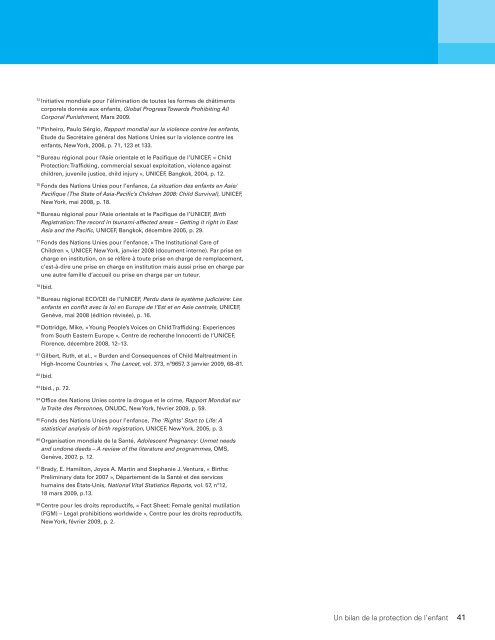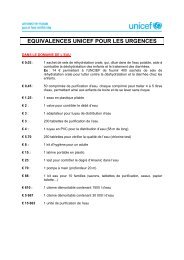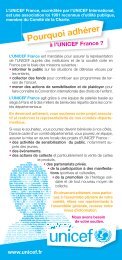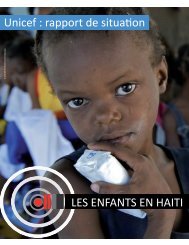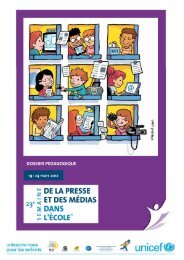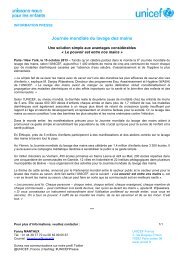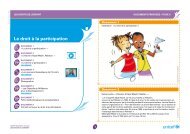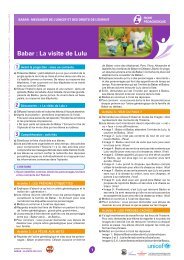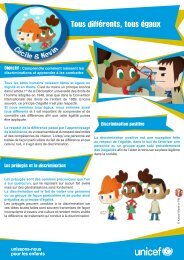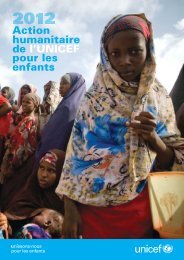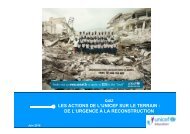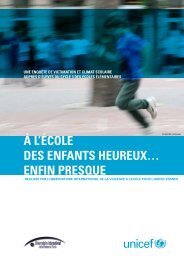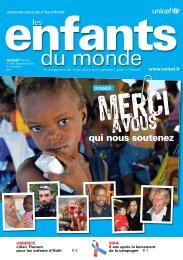34Coalition contre <strong>les</strong> sous-munitions, « Treaty Status », CMC, Londres,, consulté le 7 mai <strong>2009</strong>.35World Vision Canada, Small Arms and Children : Progress since 2001 andrecommandations for further action, World Vision Canada, Mississauga, 2006.36Office des Nations Unies contre la drogue et le crime, Rapport Mondial surla Traite des Personnes, ONUDC, New York, février <strong>2009</strong>, 92–109.37Bureau régional <strong>pour</strong> l’Afrique de l’Ouest et du Centre de l’UNICEF, « Laprogrammation <strong>pour</strong> <strong>les</strong> Orphelins et autres Enfants Vulnérab<strong>les</strong> (OEV) ycompris <strong>les</strong> <strong>enfants</strong> affectés par le VIH et le SIDA en Afrique de l’Ouest etdu Centre », Document de travail, UNICEF, Dakar, novembre 2008, p. 15.38Fonds des Nations Unies <strong>pour</strong> l’enfance, Rapport sur l’action humanitaire<strong>2009</strong>, UNICEF, New York, <strong>2009</strong>, p. 173.39Bureau régional <strong>pour</strong> l’Afrique de l’Ouest et du Centre de l’UNICEF, « Abus,exploitation et violence sexuels à l’encontre des <strong>enfants</strong> à l’école en Afriquede l’Ouest et du Centre : analyse de la situation », UNICEF, Dakar, 2006; et leBureau régional <strong>pour</strong> l’Afrique de l’Ouest et du Centre de l’UNICEF, « DeskReview of Evidence about Violence within Education Settings in West andCentral Africa », UNICEF, Dakar, octobre 2008 (documents internes).40Centre <strong>pour</strong> <strong>les</strong> droits reproductifs, « Fact Sheet: Female genital mutilation(FGM) – Legal prohibitions worldwide », Centre <strong>pour</strong> <strong>les</strong> droits reproductifs,New York, février <strong>2009</strong>, p. 1.41Fonds des Nations Unies <strong>pour</strong> l’enfance, Enfants et SIDA. Troisième bilan dela situation 2008, UNICEF, New York, décembre 2008, p. 44; et l’analyse del’UNICEF sur <strong>les</strong> données de l’ONUSIDA (document interne).42Ibid.43Enquêtes démographiques et sanitaires, 2003–2007.44Équipe spéciale inter-institutions sur <strong>les</strong> <strong>enfants</strong> et l’équipe spécialeinter-institutions sur des plans d’action nationaux en matière de VIH/SIDA,« National Responses for Children Affected by AIDS: Review of progress and<strong>les</strong>sons learned », IATT, New York, août 2008, 11–13.45Clark, Shelley, « Early Marriage and HIV Risks in Sub-Saharan Africa »,Studies in Family Planning, vol. 35, nº3, septembre 2004, 149–160.46Centre <strong>pour</strong> <strong>les</strong> droits reproductifs. « Fact Sheet: Female genital mutilation(FGM) – Legal prohibitions worldwide », Centre <strong>pour</strong> <strong>les</strong> droits reproductifs,New York, février <strong>2009</strong>, p. 1.47Fonds des Nations Unies <strong>pour</strong> l’enfance, Rapport sur l’action humanitaire<strong>2009</strong>, UNICEF, New York, <strong>2009</strong>, p. 59.48Bureau régional de l’Asie du Sud de l’UNICEF, « Early Marriage in South Asia:a discussion paper », UNICEF, Katmandou, n.d., p. 7.49Kane, June, « Regional Consultation on Violence Against Children in SouthAsia », Atar Roto Presse SA, Islamabad, 19-21 mai 2005, pp.9-10.50Centre de recherche Innocenti de l’UNICEF, « South Asia in Action:Preventing and responding to child trafficking – child rights-based programmepractices », Fonds des Nations Unies <strong>pour</strong> l’enfance, Florence,octobre 2008, p. 3.51Office des Nations Unies contre la drogue et le crime, Rapport Mondial surla Traite des Personnes, ONUDC, New York, février <strong>2009</strong>, p. 67.52Centre de recherche Innocenti de l’UNICEF, « South Asia in Action: Preventingand responding to child trafficking – child rights-based programme practices »,Fonds des Nations Unies <strong>pour</strong> l’enfance, Florence, octobre 2008, p. 3.53Fonds des Nations Unies <strong>pour</strong> l’enfance, Rapport sur l’action humanitaire<strong>2009</strong>, UNICEF, New York, <strong>2009</strong>, 34, 39.54Bureau régional de l’Asie du Sud de l’UNICEF, « Regional Analysis Report2007 », UNICEF, Katmandou (document interne).55Bureau régional de l’Asie du Sud de l’UNICEF, « Juvenile Justice in SouthAsia: Improving protection for children in conflict with the law », UNICEF,Katmandou, 2006, Avant-propos.56Pinheiro, Paulo Sérgio, Rapport mondial sur la violence contre <strong>les</strong> <strong>enfants</strong>,Étude du Secrétaire général des Nations Unies sur la violence contre <strong>les</strong><strong>enfants</strong>, New York, 2006, p. 71.57Centre <strong>pour</strong> <strong>les</strong> droits reproductifs, « Fact Sheet: Female genital mutilation(FGM) – Legal prohibitions worldwide », Centre <strong>pour</strong> <strong>les</strong> droits reproductifs,New York, février <strong>2009</strong>, p. 1.58Initiative mondiale <strong>pour</strong> l’élimination de toutes <strong>les</strong> formes de châtimentscorporels donnés aux <strong>enfants</strong>, « Global Progress Towards Prohibiting AllCorporal Punishment », mars <strong>2009</strong>.59Fonds des Nations Unies <strong>pour</strong> l’enfance, Rapport sur l’action humanitaire<strong>2009</strong>, UNICEF, New York, <strong>2009</strong>, p. 42.60Bencomo, Clarisa, The Last Holdouts: Ending the death penalty in Iran,Saudi Arabia, Sudan, Pakistan and Yemen, Human Rights Watch, New York,septembre 2008, p. 1.61Organisation mondiale de la Santé, Premier rapport mondial sur la violenceet la santé, OMS, Genève, 2002, cité dans Fonds des Nations Unies <strong>pour</strong>l’enfance, « The Impact of Small Arms on Children and Ado<strong>les</strong>cents inCentral America and the Caribbean: A case study of El Salvador, Guatemala,Jamaica and Trinidad and Tobago », UNICEF, New York, 2007, p. 4, 14 et 64.62Fonds des Nations Unies <strong>pour</strong> l’enfance « The Impact of Small Arms onChildren and Ado<strong>les</strong>cents in Central America and the Caribbean: A casestudy of El Salvador, Guatemala, Jamaica and Trinidad and Tobago »,UNICEF, New York, 2007, pp. 19, 64.63Ibid., pp.14, 20.64Ibid., p.57.65Van den Berge, Marten, et al., « The Worst Forms of Child Labour inLatin America: Identification and policy options – Main findings fromGuatemala, Bolivia and Peru », International Research on Working ChildrenFoundation, Amsterdam, 2008.66Office des Nations Unies contre la drogue et le crime, Global Report onTrafficking in Persons, ONUDC, New York, février <strong>2009</strong>, 65–66.67Pflug, Bharati, « An Overview of Child Domestic Workers in Asia »,Organisation internationale du Travail, Genève, n.d., p. 7.68Organisation internationale du Travail, Rapport d’enquête: Child domesticworkers in Ho Chi Minh City, Bureau régional <strong>pour</strong> l’Asie et le Pacifique del’OIT, Bangkok, Mars 2006, p. 13.69Organisation internationale du Travail, Rapport d’enquête: Child domesticworkers in Ho Chi Minh City, Bureau régional <strong>pour</strong> l’Asie et le Pacifique del’OIT, Bangkok, Mars 2006, p. 33, et l’Organisation internationale <strong>pour</strong> <strong>les</strong>migrations, Out of Sight, Out of Mind? Child domestic workers and patternsof trafficking in Cambodia, OIM, Genève, janvier 2007, p. 8.70Bureau régional <strong>pour</strong> l’Asie orientale et le Pacifique de l’UNICEF, ChildTrafficking in East and Southeast Asia: Reversing the trend, Versiondéfinitive, UNICEF, Bangkok, décembre 2008 (document interne).71Pinheiro, Paulo Sérgio, Rapport mondial sur la violence contre <strong>les</strong> <strong>enfants</strong>,Étude du Secrétaire général des Nations Unies sur la violence contre <strong>les</strong><strong>enfants</strong>, New York, 2006, p. 71.40 Progrès <strong>pour</strong> <strong>les</strong> <strong>enfants</strong>
72Initiative mondiale <strong>pour</strong> l’élimination de toutes <strong>les</strong> formes de châtimentscorporels donnés aux <strong>enfants</strong>, Global Progress Towards Prohibiting AllCorporal Punishment, Mars <strong>2009</strong>.73Pinheiro, Paulo Sérgio, Rapport mondial sur la violence contre <strong>les</strong> <strong>enfants</strong>,Étude du Secrétaire général des Nations Unies sur la violence contre <strong>les</strong><strong>enfants</strong>, New York, 2006, p. 71, 123 et 133.74Bureau régional <strong>pour</strong> l’Asie orientale et le Pacifique de l’UNICEF, « ChildProtection: Trafficking, commercial sexual exploitation, violence againstchildren, juvenile justice, child injury », UNICEF, Bangkok, 2004, p. 12.75Fonds des Nations Unies <strong>pour</strong> l’enfance, La situation des <strong>enfants</strong> en Asie/Pacifique (The State of Asia-Pacific’s Children 2008: Child Survival), UNICEF,New York, mai 2008, p. 18.76Bureau régional <strong>pour</strong> l’Asie orientale et le Pacifique de l’UNICEF, BirthRegistration: The record in tsunami-affected areas – Getting it right in EastAsia and the Pacific, UNICEF, Bangkok, décembre 2005, p. 29.77Fonds des Nations Unies <strong>pour</strong> l’enfance, « The Institutional Care ofChildren », UNICEF, New York, janvier 2008 (document interne). Par prise encharge en institution, on se réfère à toute prise en charge de remplacement,c’est-à-dire une prise en charge en institution mais aussi prise en charge parune autre famille d’accueil ou prise en charge par un tuteur.78Ibid.79Bureau régional ECO/CEI de l’UNICEF, Perdu dans le système judiciaire: Les<strong>enfants</strong> en conflit avec la loi en Europe de l’Est et en Asie centrale, UNICEF,Genève, mai 2008 (édition révisée), p. 16.80Dottridge, Mike, « Young People’s Voices on Child Trafficking: Experiencesfrom South Eastern Europe », Centre de recherche Innocenti de l’UNICEF,Florence, décembre 2008, 12–13.81Gilbert, Ruth, et al., « Burden and Consequences of Child Maltreatment inHigh-Income Countries », The Lancet, vol. 373, nº9657, 3 janvier <strong>2009</strong>, 68–81.82Ibid.83Ibid., p. 72.84Office des Nations Unies contre la drogue et le crime, Rapport Mondial surla Traite des Personnes, ONUDC, New York, février <strong>2009</strong>, p. 59.85Fonds des Nations Unies <strong>pour</strong> l’enfance, The ‘Rights’ Start to Life: Astatistical analysis of birth registration, UNICEF, New York, 2005, p. 3.86Organisation mondiale de la Santé, Ado<strong>les</strong>cent Pregnancy: Unmet needsand undone deeds – A review of the literature and programmes, OMS,Genève, 2007, p. 12.87Brady, E. Hamilton, Joyce A. Martin and Stephanie J. Ventura, « Births:Preliminary data for 2007 », Département de la Santé et des serviceshumains des États-Unis, National Vital Statistics Reports, vol. 57, nº12,18 mars <strong>2009</strong>, p.13.88Centre <strong>pour</strong> <strong>les</strong> droits reproductifs, « Fact Sheet: Female genital mutilation(FGM) – Legal prohibitions worldwide », Centre <strong>pour</strong> <strong>les</strong> droits reproductifs,New York, février <strong>2009</strong>, p. 2.Un bilan de la protection de l’enfant41


